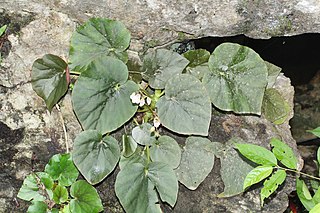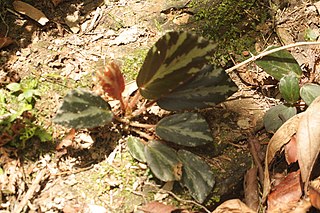
The Cucurbitales are an order of flowering plants, included in the rosid group of dicotyledons. This order mostly belongs to tropical areas, with limited presence in subtropical and temperate regions. The order includes shrubs and trees, together with many herbs and climbers. One major characteristic of the Cucurbitales is the presence of unisexual flowers, mostly pentacyclic, with thick pointed petals. The pollination is usually performed by insects, but wind pollination is also present.

Begonia is a genus of perennial flowering plants in the family Begoniaceae. The genus contains more than 2,000 different plant species. The Begonias are native to moist subtropical and tropical climates. Some species are commonly grown indoors as ornamental houseplants in cooler climates. In cooler climates some species are cultivated outside in summertime for their bright colorful flowers, which have sepals but no petals.

Begoniaceae is a family of flowering plants with two genera and about 2040 species occurring in the subtropics and tropics of both the New World and Old World. All but one of the species are in the genus Begonia. There have been many recent discoveries of species in the genus Begonia, such as Begonia truncatifolia which is endemic to San Vincente, Palawan. B. truncatifolia is smaller than other species of the genus Begonia and this new species is proposed Critically Endangered by standards set by the IUCN. The only other genus in the family, Hillebrandia, is endemic to the Hawaiian Islands and has a single species. Phylogenetic work supports Hillebrandia as the sister taxon to the rest of the family. The genus Symbegonia was reduced to a section of Begonia in 2003, as molecular phylogenies had shown it to be derived from within that genus. Members of the genus Begonia are well-known and popular houseplants.

Rhododendron section Vireya (vireyas) is a tropical group of Rhododendron species, numbering about 300 in all. The group may also be treated as Rhododendron subgenus Vireya. Vireyas are native to southeastern Asia and range from Thailand to Australia.

Begonia palmata is a species of plant in the genus Begonia of the family Begoniaceae. It is a small herb of height 20–90 cm tall. It is found in moist places, next to streams or under the shade. It is found in many parts of Asia, including eastern Himalayas.

Begonia elnidoensis is an endemic species of Begonia discovered in El Nido, Palawan, Philippines. The species was compared to Begonia wadei, in that both species have thick-trunked stem, differing in the widely to very widely ovate or subtriangular leaves, with the latter having obliquely ovate leaves, 3-4 secondary leaf veins where the latter has 6 on each side of the midrib, with glabrous petioles compared to latter having puberulous to tomentose, an inflorescence measuring 20–40 cm in length compared to only 6–20 cm, and the differently-sized bracts and capsules.
Begonia balangcodiae is an endemic species of Begonia discovered in Sagubo, Kapangan, Benguet, Philippines. The species was allied to B. esculenta Merr., from which it is distinguished by its cordate leaf base and white tepals, while the latter's leaf base is not cordate and has a vermilion-colored tepals. On the same hand, this species resembles that of B. leucosticta Warburg, differing from the latter on cordate leaf base versus subcordate leaf base, and larger tepals ranging in size from 12 to 18 mm long in pistillate flowers versus the latter's 3–5 mm. Additionally, this species is similar to B. negrosensis Elmer, in that it has lanceolate, glabrous leaf compared to that of latter's obovately oblong and sparsely hairy leaves, and white to greenish tepals, versus that of latter's pinkish tepals.
Begonia gironellae is an endemic species of Begonia discovered in Tanabag, Puerto Princesa, in northern Palawan, Philippines. The species resembled Begonia cleopatrae, in that both species have widely ovate, variegated leaves, and fleshy hairs fused into a ring at the base of the leaf petiole. However, Begonia gironellae differed from B. cleopatrae due to its rosette habit with rhizome shorter to 5 cm long, with very congested internodes, widely triangular stipules, differently-sized lamina and bracts, and capsule with wider abaxial wing. Additionally, B. gironellae is a lowland species occurring in broadleaved seaside forests, while B. cleopatrae grows on hill forest at ca. 400m.
Begonia tabonensis is an endemic species of Begonia discovered in Tabon Cave, Lipuun Point, Municipality of Quezo, in Palawan, Philippines. This species resembles B. mindorensis Merr., widely ovate and uniformly green leaves, and inflorescence with sessile glands. However the two species differs on several characteristics: Begonia tabonensis have shorter petioles(10 cm long), smaller leaves(4-8 x 4–6.4 cm); deciduous, chartaceous, glabrous or very sparsely glandular bracts; and slightly pointed, crescent-shaped ovary wing; whereas, B. mindorensis have longer petioles(25 cm long), larger leaves(10-15 x 6-10 cm); persistent, coriaceous, densely glandular bracts; and acute, triangular ovary wing.
Begonia tenuibracteata is an endemic species of Begonia discovered in Salakot Falls, Napsan, Puerto Princesa City, in northern Palawan, Philippines occurring on mossy boulders along road cut in shaded, wet lowland forest. This species, along with B. mindorensis, produces the unusual, conspicuous, persistent bracts on the inflorescences. However, it sharply distinct from the latter due to its ovate to lanceolate bracts, which are hyaline, membranaceous, glabrous or with very sparse sessile glands where the latter have widely to depressed ovate bracts that are coriaceous, densely clothed with sessile glands. Additionally, B. tenuibracteata differs by the congested rhizomes with internodes only to 3 mm long; with shorter petioles ; velvety upper leaf surface; shorter inflorescence ; and fewer stamens (40–50); whereas B. mindorensis have 20 mm long rhizome internodes, petioles 10–25 cm long, glossy upper leaf surface, inflorescence over 35 cm long, and up to ca. 70 stamens
Begonia adamsensis is an endemic species of Begonia discovered in Adams, Ilocos Norte province, Luzon, Philippines occurring at an altitude of 308 m above sea level. The species broad-based leaves that are peltate, with a glabrous peduncle, an acuminate tip and nearly entire margin, resembled that of Begonia hernandioides. However, there are differences, in that B. hernandioides had red-colored stipule that is broadly ovate, the petiole and abaxial lamina is pubescent, and the peltate leaves are elliptic.
Begonia beijnenii is a species of flowering plant in the family Begoniaceae, native to the island of Palawan in the Philippines.
Begonia cabanillasii is a species of flowering plant in the family Begoniaceae, native to the island of Palawan in the Philippines.

Begonia caramoanensis is a species of flowering plant in the family Begoniaceae, native to the island of Luzon in the Philippines.

Begonia truncatifolia is a species of flowering plant in the family Begoniaceae, native to the island of Palawan in the Philippines.
The Philippine Taxonomic Initiative (PTI) is a private Philippine research institute and non-profit organization founded in 2018, located in the Philippines.

Begonia noraaunorae is an endemic species of Begonia found in Surigao del Sur, Mindanao Island, Philippines. The species was compared to B. negrosensis Elmer, from which it resembled by its glabrous stems, leaves that are obovately oblong in shape and with sparse hairs, the lamina with glossy surface adaxially and light green abaxially, the staminate flowers having 2 tepals, the pistillate flowers having 5 tepals, and the green ovaries. However, this species differed from B. negrosensis by its larger leaves with scattered light green patches, shorter stems, a much larger, serrated lamina, shape of tepals of staminate flower, and longer ovary with no subtending bracteoles. The species is named after the Filipina actress and National Artist, Nora Aunor. The species is classified under IUCN Red List criteria as Vulnerable.

Plantago unibracteata is a species of flowering plant in the family Plantaginaceae that is endemic to New Zealand. Knud Rahn gave the species its current name in 1996, based on Joseph Dalton Hooker's original description in 1854. Plants of this species of plantain are perennial with a rosette habit, with narrowly angular-ovate leaves with few teeth, and numerous angular or rounded seeds.

Plantago lanigera is a species of flowering plant in the family Plantaginaceae that is endemic to New Zealand. Joseph Dalton Hooker described P. lanigera in 1864. Plants of this species of plantain are perennial with a rosette habit, leaves widest above the middle, few small angular to rounded seeds per capsule, glabrous bracts and sepals, and punctate leaves. It is listed as Not Threatened.

Plantago raoulii is a species of flowering plant in the family Plantaginaceae that is endemic to New Zealand. Joseph Decaisne described P. raoulii in 1852. Plants of this species of plantain are perennial with a rosette habit, leaves widest above the middle, usually 5 seeds in a specific arrangement in each capsule, and bracts with mostly glabrous edges. It is listed as Not Threatened.











